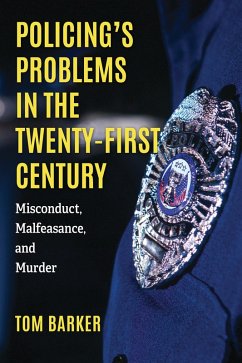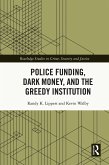Tom Barker
Policing's Problems in the Twenty-First Century (eBook, PDF)
Misconduct, Malfeasance, and Murder
18,95 €
18,95 €
inkl. MwSt.
Sofort per Download lieferbar

9 °P sammeln
18,95 €
Als Download kaufen

18,95 €
inkl. MwSt.
Sofort per Download lieferbar

9 °P sammeln
Jetzt verschenken
Alle Infos zum eBook verschenken
18,95 €
inkl. MwSt.
Sofort per Download lieferbar
Alle Infos zum eBook verschenken

9 °P sammeln
Tom Barker
Policing's Problems in the Twenty-First Century (eBook, PDF)
Misconduct, Malfeasance, and Murder
- Format: PDF
- Merkliste
- Auf die Merkliste
- Bewerten Bewerten
- Teilen
- Produkt teilen
- Produkterinnerung
- Produkterinnerung

Bitte loggen Sie sich zunächst in Ihr Kundenkonto ein oder registrieren Sie sich bei
bücher.de, um das eBook-Abo tolino select nutzen zu können.
Hier können Sie sich einloggen
Hier können Sie sich einloggen
Sie sind bereits eingeloggt. Klicken Sie auf 2. tolino select Abo, um fortzufahren.

Bitte loggen Sie sich zunächst in Ihr Kundenkonto ein oder registrieren Sie sich bei bücher.de, um das eBook-Abo tolino select nutzen zu können.
Based on personal experience and academic research, Tom Barker shines a light on the dark side of American policing by examining misconduct and corruption as occupational and workplace forms of deviance. Barker outlines patterns of rule breaking and criminal behavior while providing strategies for management and control. This textbook is appropriate for undergraduate and graduate courses in criminal justice, criminology, justice studies, sociology, and public administration.
- Geräte: PC
- mit Kopierschutz
- eBook Hilfe
- Größe: 3.48MB
Andere Kunden interessierten sich auch für
![Policing's Problems in the Twenty-First Century (eBook, ePUB) Policing's Problems in the Twenty-First Century (eBook, ePUB)]() Tom BarkerPolicing's Problems in the Twenty-First Century (eBook, ePUB)18,95 €
Tom BarkerPolicing's Problems in the Twenty-First Century (eBook, ePUB)18,95 €![Police Corruption (eBook, PDF) Police Corruption (eBook, PDF)]() Maurice PunchPolice Corruption (eBook, PDF)41,95 €
Maurice PunchPolice Corruption (eBook, PDF)41,95 €![The Fascination with Violence in Contemporary Society (eBook, PDF) The Fascination with Violence in Contemporary Society (eBook, PDF)]() Oriana BinikThe Fascination with Violence in Contemporary Society (eBook, PDF)72,95 €
Oriana BinikThe Fascination with Violence in Contemporary Society (eBook, PDF)72,95 €![Ted Bundy and The Unsolved Murder Epidemic (eBook, PDF) Ted Bundy and The Unsolved Murder Epidemic (eBook, PDF)]() Matt DelisiTed Bundy and The Unsolved Murder Epidemic (eBook, PDF)28,95 €
Matt DelisiTed Bundy and The Unsolved Murder Epidemic (eBook, PDF)28,95 €![Law Enforcement-Perpetrated Homicides (eBook, PDF) Law Enforcement-Perpetrated Homicides (eBook, PDF)]() Tom BarkerLaw Enforcement-Perpetrated Homicides (eBook, PDF)26,95 €
Tom BarkerLaw Enforcement-Perpetrated Homicides (eBook, PDF)26,95 €![Police Funding, Dark Money, and the Greedy Institution (eBook, PDF) Police Funding, Dark Money, and the Greedy Institution (eBook, PDF)]() Randy K. LippertPolice Funding, Dark Money, and the Greedy Institution (eBook, PDF)39,95 €
Randy K. LippertPolice Funding, Dark Money, and the Greedy Institution (eBook, PDF)39,95 €![Richard Quinney (eBook, PDF) Richard Quinney (eBook, PDF)]() Clemens BartollasRichard Quinney (eBook, PDF)64,95 €
Clemens BartollasRichard Quinney (eBook, PDF)64,95 €-
-
-
Based on personal experience and academic research, Tom Barker shines a light on the dark side of American policing by examining misconduct and corruption as occupational and workplace forms of deviance. Barker outlines patterns of rule breaking and criminal behavior while providing strategies for management and control. This textbook is appropriate for undergraduate and graduate courses in criminal justice, criminology, justice studies, sociology, and public administration.
Produktdetails
- Produktdetails
- Verlag: Bloomsbury eBooks US
- Seitenzahl: 306
- Erscheinungstermin: 9. September 2024
- Englisch
- ISBN-13: 9798881868260
- Artikelnr.: 74847594
- Verlag: Bloomsbury eBooks US
- Seitenzahl: 306
- Erscheinungstermin: 9. September 2024
- Englisch
- ISBN-13: 9798881868260
- Artikelnr.: 74847594
- Herstellerkennzeichnung Die Herstellerinformationen sind derzeit nicht verfügbar.
Tom Barker is a former police officer, a police academy instructor, a college and university instructor, and a college dean. He is a past president of the Academy of Criminal Justice Studies. He has authored or coauthored seventeen books, including six that have gone into multiple editions-one, nine editions. Dr. Barker is considered a national and international expert in several areas: law-enforcement practices, including reform, and adult criminal gangs-street, prison, and outlaw motorcycle gangs. Since his retirement from college teaching in 2000, he has devoted his time to full-time writing and research.
Preface: Looking in the Rear View Mirror
First Attempt at Police Deviance Classification
Intersection of Occupational and Organizational Factors: Workplace Setting
Policing's Dark Side
Part I: The Genesis
Chapter 1: Overview of Police Deviance
Local American Policework Misconduct, Malfeasance, and Homicide
Police Misconduct is a Social Justice Issue
American Police Reform
Conclusion
Discussion Questions
Chapter 2: Policing's Paradox
Evolution of Policing
The Development of American Policing
Code of Ethics Violated from the Beginning
Conclusion
Discussion Questions
Part II: Types and Patterns of Police Deviance: Police Misconduct
Chapter 3: Police Sexual Misconduct and its Types
Police Sexual Misconduct: The Sleazy Blue Line
Typology of American Police Sexual Misconduct
Conclusion
Discussion Questions
Chapter 4: Police Misconduct: Police Lying
Police Lying Is Normal Police Behavior
Police Lying in Its Historical Context
American Policing and Police Lying
Categories of Police Lies
Dealing With Cops with Known Credibility Problems
Conclusion
Discussion Questions
Chapter 5: Wrongful Convictions: False Confessions and Official Misconduct
False Confessions Resulting from Police Torture
The American Accusatory Interrogation System: Through the Guilt-Presumptive
Lens
Wrongful Convictions
Conclusion
Discussion Questions
Chapter 6: Expanding Police Misconduct: Misuse of Confidential Information,
Identity Theft, and Stealing Time
Misuse of Confidential Information
American Crime-Sharing Database Misuse
Identity Theft by Law-Enforcement Officers
Police Misconduct: Stealing Time
Conclusion
Discussion Questions
Part III: Police Corruption and Criminal Law-Enforcement Officers:
Malfeasance
Chapter 7: Rule Breaking Cops: Malfeasance
Patterns of Police Corruption
Conclusion
Discussion Question
Chapter 8: Criminal Cops: When the Bad Guys Wear Badges
A Brief History of American Criminal Cops
Police Graft in America: The Beginning
American Systematic Police Corruption and Crime in the 1970s and 1980s
What is the Nature and Extent of American Police Crimes?
Conclusion
Discussion Questions
Chapter 9: "Bad to the Bone" Killer Cops and Criminal Cop Drug Dealers
Criminal Cops: A Historical Fact
National and International Police Occupational Problems
Conclusion
Discussion Questions
Chapter 10: Federal and Corrections Law-Enforcement Occupational or
Workplace Deviance
Corrections Agencies and Corrections Officers
Federal Law-Enforcement Agencies
Discussion Questions
Chapter 11: Twenty-First-Century American Policing
American Police-Work Occupation
Twenty-First-Century American Policing Behavior
Déjà Vu All over Again
Conclusion
References
Index
About the Author
First Attempt at Police Deviance Classification
Intersection of Occupational and Organizational Factors: Workplace Setting
Policing's Dark Side
Part I: The Genesis
Chapter 1: Overview of Police Deviance
Local American Policework Misconduct, Malfeasance, and Homicide
Police Misconduct is a Social Justice Issue
American Police Reform
Conclusion
Discussion Questions
Chapter 2: Policing's Paradox
Evolution of Policing
The Development of American Policing
Code of Ethics Violated from the Beginning
Conclusion
Discussion Questions
Part II: Types and Patterns of Police Deviance: Police Misconduct
Chapter 3: Police Sexual Misconduct and its Types
Police Sexual Misconduct: The Sleazy Blue Line
Typology of American Police Sexual Misconduct
Conclusion
Discussion Questions
Chapter 4: Police Misconduct: Police Lying
Police Lying Is Normal Police Behavior
Police Lying in Its Historical Context
American Policing and Police Lying
Categories of Police Lies
Dealing With Cops with Known Credibility Problems
Conclusion
Discussion Questions
Chapter 5: Wrongful Convictions: False Confessions and Official Misconduct
False Confessions Resulting from Police Torture
The American Accusatory Interrogation System: Through the Guilt-Presumptive
Lens
Wrongful Convictions
Conclusion
Discussion Questions
Chapter 6: Expanding Police Misconduct: Misuse of Confidential Information,
Identity Theft, and Stealing Time
Misuse of Confidential Information
American Crime-Sharing Database Misuse
Identity Theft by Law-Enforcement Officers
Police Misconduct: Stealing Time
Conclusion
Discussion Questions
Part III: Police Corruption and Criminal Law-Enforcement Officers:
Malfeasance
Chapter 7: Rule Breaking Cops: Malfeasance
Patterns of Police Corruption
Conclusion
Discussion Question
Chapter 8: Criminal Cops: When the Bad Guys Wear Badges
A Brief History of American Criminal Cops
Police Graft in America: The Beginning
American Systematic Police Corruption and Crime in the 1970s and 1980s
What is the Nature and Extent of American Police Crimes?
Conclusion
Discussion Questions
Chapter 9: "Bad to the Bone" Killer Cops and Criminal Cop Drug Dealers
Criminal Cops: A Historical Fact
National and International Police Occupational Problems
Conclusion
Discussion Questions
Chapter 10: Federal and Corrections Law-Enforcement Occupational or
Workplace Deviance
Corrections Agencies and Corrections Officers
Federal Law-Enforcement Agencies
Discussion Questions
Chapter 11: Twenty-First-Century American Policing
American Police-Work Occupation
Twenty-First-Century American Policing Behavior
Déjà Vu All over Again
Conclusion
References
Index
About the Author
Preface: Looking in the Rear View Mirror
First Attempt at Police Deviance Classification
Intersection of Occupational and Organizational Factors: Workplace Setting
Policing's Dark Side
Part I: The Genesis
Chapter 1: Overview of Police Deviance
Local American Policework Misconduct, Malfeasance, and Homicide
Police Misconduct is a Social Justice Issue
American Police Reform
Conclusion
Discussion Questions
Chapter 2: Policing's Paradox
Evolution of Policing
The Development of American Policing
Code of Ethics Violated from the Beginning
Conclusion
Discussion Questions
Part II: Types and Patterns of Police Deviance: Police Misconduct
Chapter 3: Police Sexual Misconduct and its Types
Police Sexual Misconduct: The Sleazy Blue Line
Typology of American Police Sexual Misconduct
Conclusion
Discussion Questions
Chapter 4: Police Misconduct: Police Lying
Police Lying Is Normal Police Behavior
Police Lying in Its Historical Context
American Policing and Police Lying
Categories of Police Lies
Dealing With Cops with Known Credibility Problems
Conclusion
Discussion Questions
Chapter 5: Wrongful Convictions: False Confessions and Official Misconduct
False Confessions Resulting from Police Torture
The American Accusatory Interrogation System: Through the Guilt-Presumptive
Lens
Wrongful Convictions
Conclusion
Discussion Questions
Chapter 6: Expanding Police Misconduct: Misuse of Confidential Information,
Identity Theft, and Stealing Time
Misuse of Confidential Information
American Crime-Sharing Database Misuse
Identity Theft by Law-Enforcement Officers
Police Misconduct: Stealing Time
Conclusion
Discussion Questions
Part III: Police Corruption and Criminal Law-Enforcement Officers:
Malfeasance
Chapter 7: Rule Breaking Cops: Malfeasance
Patterns of Police Corruption
Conclusion
Discussion Question
Chapter 8: Criminal Cops: When the Bad Guys Wear Badges
A Brief History of American Criminal Cops
Police Graft in America: The Beginning
American Systematic Police Corruption and Crime in the 1970s and 1980s
What is the Nature and Extent of American Police Crimes?
Conclusion
Discussion Questions
Chapter 9: "Bad to the Bone" Killer Cops and Criminal Cop Drug Dealers
Criminal Cops: A Historical Fact
National and International Police Occupational Problems
Conclusion
Discussion Questions
Chapter 10: Federal and Corrections Law-Enforcement Occupational or
Workplace Deviance
Corrections Agencies and Corrections Officers
Federal Law-Enforcement Agencies
Discussion Questions
Chapter 11: Twenty-First-Century American Policing
American Police-Work Occupation
Twenty-First-Century American Policing Behavior
Déjà Vu All over Again
Conclusion
References
Index
About the Author
First Attempt at Police Deviance Classification
Intersection of Occupational and Organizational Factors: Workplace Setting
Policing's Dark Side
Part I: The Genesis
Chapter 1: Overview of Police Deviance
Local American Policework Misconduct, Malfeasance, and Homicide
Police Misconduct is a Social Justice Issue
American Police Reform
Conclusion
Discussion Questions
Chapter 2: Policing's Paradox
Evolution of Policing
The Development of American Policing
Code of Ethics Violated from the Beginning
Conclusion
Discussion Questions
Part II: Types and Patterns of Police Deviance: Police Misconduct
Chapter 3: Police Sexual Misconduct and its Types
Police Sexual Misconduct: The Sleazy Blue Line
Typology of American Police Sexual Misconduct
Conclusion
Discussion Questions
Chapter 4: Police Misconduct: Police Lying
Police Lying Is Normal Police Behavior
Police Lying in Its Historical Context
American Policing and Police Lying
Categories of Police Lies
Dealing With Cops with Known Credibility Problems
Conclusion
Discussion Questions
Chapter 5: Wrongful Convictions: False Confessions and Official Misconduct
False Confessions Resulting from Police Torture
The American Accusatory Interrogation System: Through the Guilt-Presumptive
Lens
Wrongful Convictions
Conclusion
Discussion Questions
Chapter 6: Expanding Police Misconduct: Misuse of Confidential Information,
Identity Theft, and Stealing Time
Misuse of Confidential Information
American Crime-Sharing Database Misuse
Identity Theft by Law-Enforcement Officers
Police Misconduct: Stealing Time
Conclusion
Discussion Questions
Part III: Police Corruption and Criminal Law-Enforcement Officers:
Malfeasance
Chapter 7: Rule Breaking Cops: Malfeasance
Patterns of Police Corruption
Conclusion
Discussion Question
Chapter 8: Criminal Cops: When the Bad Guys Wear Badges
A Brief History of American Criminal Cops
Police Graft in America: The Beginning
American Systematic Police Corruption and Crime in the 1970s and 1980s
What is the Nature and Extent of American Police Crimes?
Conclusion
Discussion Questions
Chapter 9: "Bad to the Bone" Killer Cops and Criminal Cop Drug Dealers
Criminal Cops: A Historical Fact
National and International Police Occupational Problems
Conclusion
Discussion Questions
Chapter 10: Federal and Corrections Law-Enforcement Occupational or
Workplace Deviance
Corrections Agencies and Corrections Officers
Federal Law-Enforcement Agencies
Discussion Questions
Chapter 11: Twenty-First-Century American Policing
American Police-Work Occupation
Twenty-First-Century American Policing Behavior
Déjà Vu All over Again
Conclusion
References
Index
About the Author







